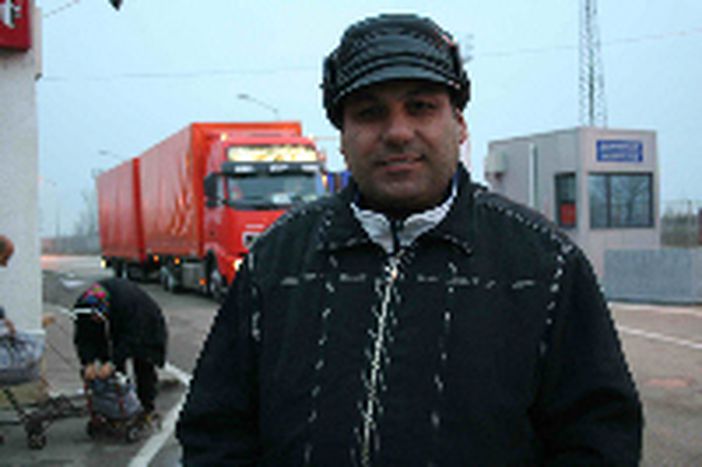
Danube II: bridging united waters
Published on
Translation by:
 ed saunders
ed saunders
The planned Danube Bridge II at Vidin-Calafat, linking Bulgaria and Romania by road and railway, had been put off for years. Work should now begin in 2007 – thanks to EU pockets
The ferry finally sets off. It’s 7:30 am, and Boris Alyoshev has been waiting in the cold for two hours to depart. In the first light of day, the boat glides across the Danube, laden with a few HGVs and a dozen people. Above the chugging of the engine only birdsong can be heard. Both riverbanks are deserted.
The crossing from the Bulgarian town of Vidin, across the Danube to the city of Calafat in Romania takes about 20 minutes. The arrival time is unpredictable though – the ferry only departs when enough HGVs are on board.
Five Euros a day
‘I’m forced to do it,’ says Boris Alyoshev, ‘I can’t live on fresh air.’ The self-employed forty year-old earns his way as a baggage handler, like others on the first crossing. Alyoshev used to work in state enterprises, but most were closed after the end of communism.
He sells Bulgarian sweets and washing powder at the market in Romania, and takes Romanian textiles back to Bulgaria. Whatever is good value and in demand, he says. If business does well, he earns around five Euros a day. ‘If there was work in Bulgaria, then I’d stay there,’ he maintains.
Delayed symbol
Jobs and an easy border crossing – promises the Danube Bridge II now bring to Vidin and Calafat. More than half of the money is being contributed by the ISPA programme of the EU and the European Investment Bank. The bridge should actually have been completed in time for the EU accession of the two countries – as a symbol of a unified Europe. But that didn’t work out.
Disputes about the location, bureaucracy and financial difficulties have delayed the start date by three years. The contractor is still being chosen. One of four competing providers will have been chosen so work can commence mid-2007. The first vehicles and trains will roll across the bridge in 2010. The bridge will improve the Pan-European Transport Corridor IV, which from one branch connects Dresden to Thessaloniki and Istanbul.
On the ground, the buzzwords are 'economic boost'. ‘The infrastructure around the bridge will bring economic development,’ says Peter Traistaru, Mayor of Calafat.
For Vidin’s community representative, Ivan Zenov, the bridge is the cure-all solution to the region’s social and economic problems. In the last few years interest from investors has already grown. ‘They are waiting for construction work to begin, so they can realise their investments.’
Emigrating and ageing
The Vidin area lies in the north-west of Bulgaria, hemmed in by Romania and Serbia. During the Yugoslav conflict the border region suffered badly, due to the trade embargo.
Today emigration and an ageing population are the biggest problems – the villages surrounding Vidin are half empty. Young people leave the region to move into larger towns or emigrate directly abroad – to Italy, Spain and Greece. The unemployment rate in the region was once almost twice as high as the Bulgarian average when it was at 8.4% (today, it rests at 12.7%).
In the industrial area on the outskirts of the town, former state enterprises are rusting away. The pump works Vipom once employed 2500 people. Now it is privatised and the staff numbers 300. Manager Ventislav Pavlov defends it for its stability. ‘We hope we will be able to expand our contact network. Vidin should become Bulgaria’s gateway to Europe.'
Neighbourly relations between the communities are good. However, in the nineties Romania and Bulgaria competed for EU membership. Despite many common problems they did not want to grow together, let alone learn from each other.
Loyal Soviet satellite
‘Model pupil’ Bulgaria has long felt the injustice of being lumped together with Romania. After Romania’s resolution to take action against corruption, however, Bulgaria was no longer so much in favour.
During socialism, Bulgaria was considered a loyal satellite of the Soviet Union, whereas Romanian president Nicolae Ceausescu chose a path independent of Moscow. The ‘Friendship Bridge’ which was built between the towns of Ruse and Giurgiu in the 1950s is the only one still standing along the 500 km border.
The morning ferry has arrived in the Romanian harbour, where willow trees line the banks, behind which lies the Romanian town of Calafat. Veselka Mateeva, 42 years old, is crossing for the first time. ‘I’m looking forward to the bridge,’ she says.
Once the bridge is built, it will be easier to visit the neighbouring country. The two are so close together, but Mateeva still remarks how the roofs of Romanian houses look different. All that is left now, she says, is to build bridges between the cultures.
Translated from Brückenschlag nach Europa


